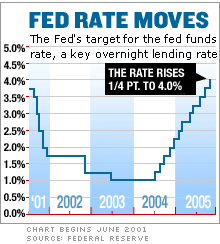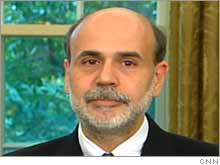 |
 |
| Will Ben Bernanke keep raising interest rates when he takes over as Fed chair or will he pause in March? |
|
|
|
|
|
|
|
|
|
|
|
NEW YORK (CNNMoney.com) -
It's two days early but the Federal Reserve appears to have given investors something to be thankful for: a strong hint that its 16-month campaign of raising interest rates may finally be nearing an end.
According to the minutes from the Fed's Nov. 1 meeting, released Tuesday, policy-makers at the central bank indicated that while they remain concerned about a possible pickup in inflation, they'll need to change the language in their closely watched statements soon.
The Fed indicated that "several aspects of the statement language would have to be changed before long, particularly those related to the characterization of and outlook for policy."
The central bank has raised the target for its federal funds rate, a key short-term rate that influences rates for consumer and corporate loans, by a quarter percentage point at each of its last 12 meetings, dating back to June 2004. In the process, short-term rates have gone from 40-year lows of 1 percent to 4 percent.
In the statements with each of those rate hikes, the Fed said "policy accommodation can be removed at a pace that is likely to be measured" -- Fed speak which investors have interpreted to mean more quarter-point increases ahead.
But given the minutes from Nov. 1, some economists say the Fed may get rid of the comments about raising rates at a "measured pace" as soon as its next meeting, on Dec. 13.
"This strongly suggests that the Fed is close to the end of this tightening process," said Mark Zandi, chief economist with Moody's Economy.com, a research Web site. "I think theres a good chance of a change in the Dec. 13 statement and that they would take out the sentence about policy accommodation being removed at a measured pace."
Other Fed watchers said the most important revelation from the newly released minutes was that the Fed appears to be concerned about what may happen to the economy if it keeps raising rates. "Some members cautioned that risks of going too far with the tightening process could also eventually emerge," the Fed minutes said. (Click here to read the full statement).
As a result, investors now appear to be less certain about how high short-term rates will head over the next few months. According to fed funds futures contracts on the Chicago Board of Trade, traders are still pricing in a strong likelihood of quarter-point rate hikes in December and January. That would bring the fed funds rate up to 4.5 percent.
But the contracts for March showed an implied rate of 4.58 percent late Tuesday, down from 4.66 percent earlier in the day, an indication investors may now be expecting a pause in March instead of another rate hike, which would leave the fed funds rate at 4.75 percent.
Handicapping rates
In the past, some have criticized the Fed and outgoing chairman Alan Greenspan for raising rates too aggressively and causing an economic slowdown. Greenspan's term will expire at the end of January and he is set to be replaced by Ben Bernanke, a former Fed governor.
Michael Cheah, manager of the SunAmerica GNMA and SunAmerica U.S. Government Securities fixed-income mutual funds, said that if the Fed doesn't stop raising rates soon, there is a risk that an unusually small difference between short-term rates and long-term bond market rates could signal an economic slowdown, or even a possible recession ahead.
Cheah said Greenspan probably wants to avoid handing off the reins of the economy to Bernanke in such a fashion.
"If the yield curve inverts, that is bad because banks will not lend money at rates lower than their borrowing costs. It's as simple as that and the economy will slow down naturally," said Cheah.
"So it makes sense for Greenspan to couch the December statement in a way that shows they are coming to an end of the rate hikes. That gives Bernanke room to start at a clean slate."
Still, despite the minutes from Nov. 1, the Fed's likely to raise short-term rates at least a few more times. So if the yield on the 10-year Treasury bond, currently at 4.42 percent, doesn't head higher soon, there is a chance of an inverted yield curve.
"I think the Fed is going to 4.5 percent regardless and we will have an inverted yield curve by the first quarter of next year. So this is a bit of a strange statement," said John Norris, chief economist with Morgan Asset Management.
"The language the Fed used may placate the markets but the conundrum persists," he added, referring to the term that Greenspan used earlier this year to describe the small difference between short-term and long-term rates.
Yet, others think that it's unwise to read too much into the Fed's comments to try and determine what Greenspan will do at his final two meetings or guess what Bernanke will do at his first meeting as new Fed chair in March.
After all, a lot can happen in the economy between now and March and the Fed minutes also said that "policy setting would need to be increasingly sensitive to incoming economic data." In other words, future Fed policy decisions shouldn't be perceived as being set in stone.
"Circumstances will dictate what happens. By March, there could be enough evidence that the economy has cooled and Bernanke can use that as justification to pause," said Barry Ritholtz, chief market strategist with Maxim Group.
For more about the bond markets, click here.
For more economic news, click here.

|